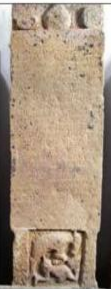Nergish Sunavala
Source - http://timesofindia.indiatimes.com/city/mumbai/Ass-curse-on-boundary-stones-is-the-subject-of-new-research-of-Mumbai-University/articleshow/51097635.cms
 Photo courtesy; CSMVS & Centre for Extra-Mural Studies, Mumbai University
Photo courtesy; CSMVS & Centre for Extra-Mural Studies, Mumbai University
There's an image of goddess Parvati at a Bhairava temple in Chirner, a village near Uran. Her face has been carved out of what was once a mangal kalash (the symbolic lota and coconut), while a sun and crescent on a lower panel—slathered in vermilion—have been fashioned into her breasts. But the lowest panel of the carved stone has a risque image of a donkey sodomizing another woman on all fours. "And what exactly is happening down there?" archaeologist Kurush Dalal asked the temple pujari, when he first spied the carving.
Dalal knew this was no ordinary image but a 'gadhegal', a unique type of land grant stone depicting a donkey fornicating with a woman. These boundary markers—issued by kings to Brahmins — once sought to keep trespassers at bay by cursing the mother of any "unworthy", who dared disobey the decree, with this vile act of bestiality.
 Behind the rebuilt Pipalwadi Shiva temple in Girgaon, Mumbai is an ancient Gaddhegal
Behind the rebuilt Pipalwadi Shiva temple in Girgaon, Mumbai is an ancient Gaddhegal
These stones are the subject of a newly-completed study by Mumbai University's Centre for Archeology and the Extra-Mural Studies Centre. In fact, Dalal, an assistant professor at the university, was at the temple to document the Chirner stone. But he had underestimated the wily pujari. "That's Parvati's steed," the priest replied nonchalantly. "He punishes people, who do wrong things."
These stones date back a thousand years to the Silaharas dynasty, which spanned the 10th-13th century AD. The most recent land grant stones date back to the 17th century. According to Dalal, no comprehensive study has ever been undertaken because the subject matter isn't considered "kosher". In fact, one researcher was so uninclined to take the curse at face value that he insisted that the woman symbolized mother earth and the donkey the steed of the goddess of pestilence.
Each stone has three panels: the topmost has the auspicious mangal kalash along with a sun and moon; another informs readers about the land grant followed by the curse, and the final panel depicts the curse in cringe-worthy clarity. The mangal kalash depicts the auspiciousness of the occasion—as the king earns merit when issuing a land grant to a Brahmin—while the sun and moon indicate the perpetuity of the ruler's reign.
Interestingly, the "ass curse" is almost always written in Marathi even when the rest of the inscription is in Sanskrit because it was directed at the common people. In later years, however, when Marathi became the court language under the Yadavas, the entire inscription was in Marathi. In fact, two of the earliest Marathi inscriptions in existence have been found on 'gadhegals'—one dating back to 1012 AD in Akshi, while another from Vihar dates back to 1018 AD. "The dating on the first is controversial because the inscription is worn out," said Dalal, "but the second is very clear and it will be celebrating a 1,000 years in 2018."
Even today, there are many Marathi curses whose origins can be traced to these stones. The use of a donkey in some of these curses might stem from the fact that it was considered an "unholy" animal. However, many of the donkeys depicted on the stones are wearing a collar, which talks about their domestication. While the researchers aren't certain yet what this symbolizes, they have painstakingly documented the ones with collars to help future researchers.
Some of the other elements tabulated include position of the woman — is she on her back or stomach—the condition of the inscription, and the script used—most are in Nagari.
A majority of these stones are found in Mumbai and Raigad because the Silaharas ruled from Thane under the auspices of the Rashtrakutas in Karnataka. "When new areas are conquered, land was granted to Brahmins," said Dalal. "The Brahmins then collect the revenue from these lands and hand a part of the profit back to the king." Thus, these grant stones are historical records of the origins of the zamindari system.
They provide a host of other important information including the extent of both the Silaharas and Yadava dynasties, the lowly position of women in society at that time, the way in which land was measured and the existing government authorities during different reigns. Ananta Deva III of the Silaharas would not be known if not for one of these stones.
When the project began only 40 land grant stones were known, but thanks to Facebook, WhatsApp and other social media, the team was able to locate over 120. They hope to expand the project to the outskirts of Maharashtra and even to states like Bihar and Orissa where similar stones exist.